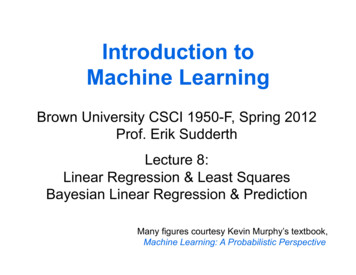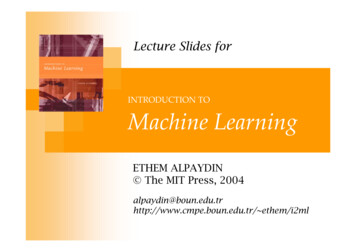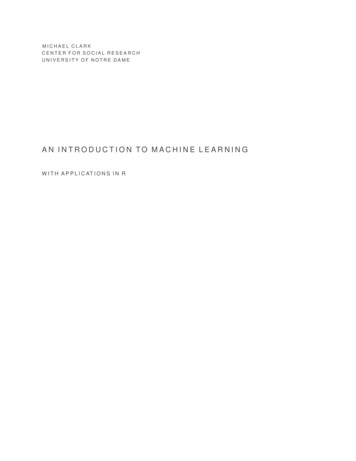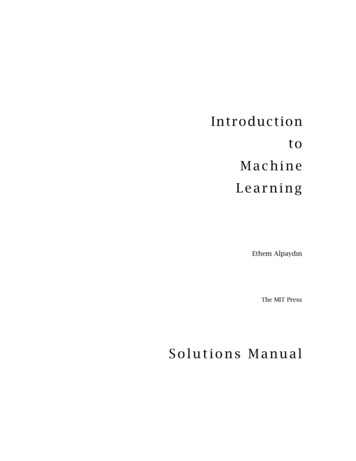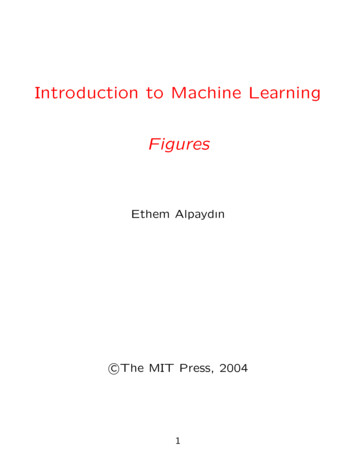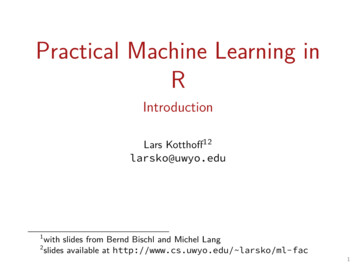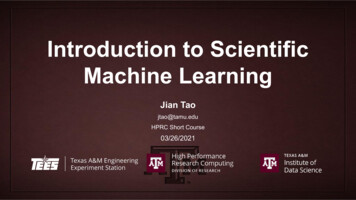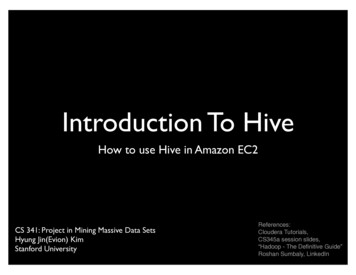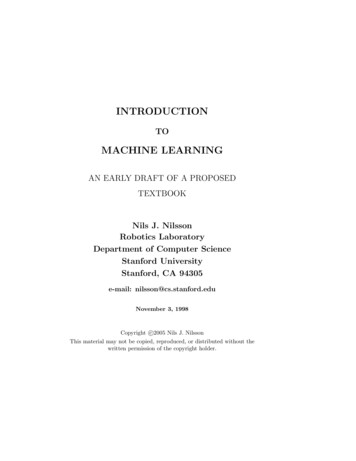
Transcription
INTRODUCTIONTOMACHINE LEARNINGAN EARLY DRAFT OF A PROPOSEDTEXTBOOKNils J. NilssonRobotics LaboratoryDepartment of Computer ScienceStanford UniversityStanford, CA 94305e-mail: nilsson@cs.stanford.eduNovember 3, 1998Copyright c 2005 Nils J. NilssonThis material may not be copied, reproduced, or distributed without thewritten permission of the copyright holder.
ii
Contents1 Preliminaries1.1 Introduction . . . . . . . . . . . . . . . .1.1.1 What is Machine Learning? . . .1.1.2 Wellsprings of Machine Learning1.1.3 Varieties of Machine Learning . .1.2 Learning Input-Output Functions . . . .1.2.1 Types of Learning . . . . . . . .1.2.2 Input Vectors . . . . . . . . . . .1.2.3 Outputs . . . . . . . . . . . . . .1.2.4 Training Regimes . . . . . . . . .1.2.5 Noise . . . . . . . . . . . . . . .1.2.6 Performance Evaluation . . . . .1.3 Learning Requires Bias . . . . . . . . . .1.4 Sample Applications . . . . . . . . . . .1.5 Sources . . . . . . . . . . . . . . . . . .1.6 Bibliographical and Historical Remarks2 Boolean Functions2.1 Representation . . . . . . . . . . . . . .2.1.1 Boolean Algebra . . . . . . . . .2.1.2 Diagrammatic Representations .2.2 Classes of Boolean Functions . . . . . .2.2.1 Terms and Clauses . . . . . . . .2.2.2 DNF Functions . . . . . . . . . .2.2.3 CNF Functions . . . . . . . . . .2.2.4 Decision Lists . . . . . . . . . . .2.2.5 Symmetric and Voting Functions2.2.6 Linearly Separable Functions . .2.3 Summary . . . . . . . . . . . . . . . . .2.4 Bibliographical and Historical 3232425
3 Using Version Spaces for Learning3.1 Version Spaces and Mistake Bounds . .3.2 Version Graphs . . . . . . . . . . . . . .3.3 Learning as Search of a Version Space .3.4 The Candidate Elimination Method . .3.5 Bibliographical and Historical Remarks.2727293232344 Neural Networks4.1 Threshold Logic Units . . . . . . . . . . . . . . . . . . . . . . . .4.1.1 Definitions and Geometry . . . . . . . . . . . . . . . . . .4.1.2 Special Cases of Linearly Separable Functions . . . . . . .4.1.3 Error-Correction Training of a TLU . . . . . . . . . . . .4.1.4 Weight Space . . . . . . . . . . . . . . . . . . . . . . . . .4.1.5 The Widrow-Hoff Procedure . . . . . . . . . . . . . . . . .4.1.6 Training a TLU on Non-Linearly-Separable Training Sets4.2 Linear Machines . . . . . . . . . . . . . . . . . . . . . . . . . . .4.3 Networks of TLUs . . . . . . . . . . . . . . . . . . . . . . . . . .4.3.1 Motivation and Examples . . . . . . . . . . . . . . . . . .4.3.2 Madalines . . . . . . . . . . . . . . . . . . . . . . . . . . .4.3.3 Piecewise Linear Machines . . . . . . . . . . . . . . . . . .4.3.4 Cascade Networks . . . . . . . . . . . . . . . . . . . . . .4.4 Training Feedforward Networks by Backpropagation . . . . . . .4.4.1 Notation . . . . . . . . . . . . . . . . . . . . . . . . . . . .4.4.2 The Backpropagation Method . . . . . . . . . . . . . . . .4.4.3 Computing Weight Changes in the Final Layer . . . . . .4.4.4 Computing Changes to the Weights in Intermediate Layers4.4.5 Variations on Backprop . . . . . . . . . . . . . . . . . . .4.4.6 An Application: Steering a Van . . . . . . . . . . . . . . .4.5 Synergies Between Neural Network and Knowledge-Based Methods4.6 Bibliographical and Historical Remarks . . . . . . . . . . . . . .35353537384042444446464950515252535658596061615 Statistical Learning5.1 Using Statistical Decision Theory . . . . . . . . . . . .5.1.1 Background and General Method . . . . . . . .5.1.2 Gaussian (or Normal) Distributions . . . . . .5.1.3 Conditionally Independent Binary Components5.2 Learning Belief Networks . . . . . . . . . . . . . . . .5.3 Nearest-Neighbor Methods . . . . . . . . . . . . . . . .5.4 Bibliographical and Historical Remarks . . . . . . . .6363636568707072iv.
6 Decision Trees6.1 Definitions . . . . . . . . . . . . . . . . . . . . . . . .6.2 Supervised Learning of Univariate Decision Trees . .6.2.1 Selecting the Type of Test . . . . . . . . . . .6.2.2 Using Uncertainty Reduction to Select Tests6.2.3 Non-Binary Attributes . . . . . . . . . . . . .6.3 Networks Equivalent to Decision Trees . . . . . . . .6.4 Overfitting and Evaluation . . . . . . . . . . . . . .6.4.1 Overfitting . . . . . . . . . . . . . . . . . . .6.4.2 Validation Methods . . . . . . . . . . . . . .6.4.3 Avoiding Overfitting in Decision Trees . . . .6.4.4 Minimum-Description Length Methods . . . .6.4.5 Noise in Data . . . . . . . . . . . . . . . . . .6.5 The Problem of Replicated Subtrees . . . . . . . . .6.6 The Problem of Missing Attributes . . . . . . . . . .6.7 Comparisons . . . . . . . . . . . . . . . . . . . . . .6.8 Bibliographical and Historical Remarks . . . . . . .7373747575797980808182838484868687. . . . . . . . . . . . . . . . . . . . . . . . . .Induction. . . . . .89. 90. 91. 94. 98. 100. 101. 1048 Computational Learning Theory8.1 Notation and Assumptions for PAC Learning Theory . . . . . .8.2 PAC Learning . . . . . . . . . . . . . . . . . . . . . . . . . . . .8.2.1 The Fundamental Theorem . . . . . . . . . . . . . . . .8.2.2 Examples . . . . . . . . . . . . . . . . . . . . . . . . . .8.2.3 Some Properly PAC-Learnable Classes . . . . . . . . . .8.3 The Vapnik-Chervonenkis Dimension . . . . . . . . . . . . . . .8.3.1 Linear Dichotomies . . . . . . . . . . . . . . . . . . . . .8.3.2 Capacity . . . . . . . . . . . . . . . . . . . . . . . . . .8.3.3 A More General Capacity Result . . . . . . . . . . . . .8.3.4 Some Facts and Speculations About the VC Dimension8.4 VC Dimension and PAC Learning . . . . . . . . . . . . . . . .8.5 Bibliographical and Historical Remarks . . . . . . . . . . . . .1071071091091111121131131151161171181187 Inductive Logic Programming7.1 Notation and Definitions . . . . . . . . .7.2 A Generic ILP Algorithm . . . . . . . .7.3 An Example . . . . . . . . . . . . . . . .7.4 Inducing Recursive Programs . . . . . .7.5 Choosing Literals to Add . . . . . . . .7.6 Relationships Between ILP and Decision7.7 Bibliographical and Historical Remarksv. . . . . . . . . . .Tree. . .
9 Unsupervised Learning1199.1What is Unsupervised Learning? . . . . . . . . . . . . . . . . . . 1199.2Clustering Methods . . . . . . . . . . . . . . . . . . . . . . . . . . 1209.39.49.2.1A Method Based on Euclidean Distance . . . . . . . . . . 1209.2.2A Method Based on Probabilities . . . . . . . . . . . . . . 124Hierarchical Clustering Methods . . . . . . . . . . . . . . . . . . 1259.3.1A Method Based on Euclidean Distance . . . . . . . . . . 1259.3.2A Method Based on Probabilities . . . . . . . . . . . . . . 126Bibliographical and Historical Remarks . . . . . . . . . . . . . . 13010 Temporal-Difference Learning13110.1 Temporal Patterns and Prediction Problems . . . . . . . . . . . . 13110.2 Supervised and Temporal-Difference Methods . . . . . . . . . . . 13110.3 Incremental Computation of the ( W)i . . . . . . . . . . . . . . 13410.4 An Experiment with TD Methods . . . . . . . . . . . . . . . . . 13510.5 Theoretical Results . . . . . . . . . . . . . . . . . . . . . . . . . . 13810.6 Intra-Sequence Weight Updating . . . . . . . . . . . . . . . . . . 13810.7 An Example Application: TD-gammon . . . . . . . . . . . . . . . 14010.8 Bibliographical and Historical Remarks . . . . . . . . . . . . . . 14111 Delayed-Reinforcement Learning14311.1 The General Problem . . . . . . . . . . . . . . . . . . . . . . . . 14311.2 An Example . . . . . . . . . . . . . . . . . . . . . . . . . . . . . . 14411.3 Temporal Discounting and Optimal Policies . . . . . . . . . . . . 14511.4 Q-Learning . . . . . . . . . . . . . . . . . . . . . . . . . . . . . . 14711.5 Discussion, Limitations, and Extensions of Q-Learning . . . . . . 15011.5.1 An Illustrative Example . . . . . . . . . . . . . . . . . . . 15011.5.2 Using Random Actions. . . . . . . . . . . . . . . . . . . 15211.5.3 Generalizing Over Inputs . . . . . . . . . . . . . . . . . . 15311.5.4 Partially Observable States . . . . . . . . . . . . . . . . . 15411.5.5 Scaling Problems . . . . . . . . . . . . . . . . . . . . . . . 15411.6 Bibliographical and Historical Remarks . . . . . . . . . . . . . . 155vi
12 Explanation-Based Learning15712.1 Deductive Learning . . . . . . . . . . . . . . . . . . . . . . . . . . 15712.2 Domain Theories . . . . . . . . . . . . . . . . . . . . . . . . . . . 15812.3 An Example . . . . . . . . . . . . . . . . . . . . . . . . . . . . . . 15912.4 Evaluable Predicates . . . . . . . . . . . . . . . . . . . . . . . . . 16212.5 More General Proofs . . . . . . . . . . . . . . . . . . . . . . . . . 16412.6 Utility of EBL . . . . . . . . . . . . . . . . . . . . . . . . . . . . 16412.7 Applications . . . . . . . . . . . . . . . . . . . . . . . . . . . . . . 16412.7.1 Macro-Operators in Planning . . . . . . . . . . . . . . . . 16412.7.2 Learning Search Control Knowledge . . . . . . . . . . . . 16712.8 Bibliographical and Historical Remarks . . . . . . . . . . . . . . 168vii
viii
PrefaceThese notes are in the process of becoming a textbook. The process is quiteunfinished, and the author solicits corrections, criticisms, and suggestions fromstudents and other readers. Although I have tried to eliminate errors, some undoubtedly remain—caveat lector. Many typographical infelicities will no doubtpersist until the final version. More material has yet to be added. Please letme have your suggestions about topics that are too important to be left out.I hope that future versions will cover Hopfield nets, Elman nets and other recurrent nets, radial basis functions, grammar and automata learning, geneticalgorithms, and Bayes networks . . . I am also collecting exercises and projectsuggestions which will appear in future versions.My intention is to pursue a middle ground between a theoretical textbookand one that focusses on applications. The book concentrates on the importantideas in machine learning. I do not give proofs of many of the theorems that Istate, but I do give plausibility arguments and citations to formal proofs. And, Ido not treat many matters that would be of practical importance in applications;the book is not a handbook of machine learning practice. Instead, my goal isto give the reader sufficient preparation to make the extensive literature onmachine learning accessible.Students in my Stanford courses on machine learning have already madeseveral useful suggestions, as have my colleague, Pat Langley, and my teachingassistants, Ron Kohavi, Karl Pfleger, Robert Allen, and Lise Getoor.ixSome of my plans for additions andother reminders are mentioned inmarginal notes.
Chapter 1Preliminaries1.11.1.1IntroductionWhat is Machine Learning?Learning, like intelligence, covers such a broad range of processes that it is difficult to define precisely. A dictionary definition includes phrases such as “togain knowledge, or understanding of, or skill in, by study, instruction, or experience,” and “modification of a behavioral tendency by experience.” Zoologistsand psychologists study learning in animals and humans. In this book we focus on learning in machines. There are several parallels between animal andmachine learning. Certainly, many techniques in machine learning derive fromthe efforts of psychologists to make more precise their theories of animal andhuman learning through computational models. It seems likely also that theconcepts and techniques being explored by researchers in machine learning mayilluminate certain aspects of biological learning.As regards machines, we might say, very broadly, that a machine learnswhenever it changes its structure, program, or data (based on its inputs or inresponse to external information) in such a manner that its expected futureperformance improves. Some of these changes, such as the addition of a recordto a data base, fall comfortably within the province of other disciplines and arenot necessarily better understood for being called learning. But, for example,when the performance of a speech-recognition machine improves after hearingseveral samples of a person’s speech, we feel quite justified in that case to saythat the machine has learned.Machine learning usually refers to the changes in systems that perform tasksassociated with artificial intelligence (AI). Such tasks involve recognition, diagnosis, planning, robot control, prediction, etc. The “changes” might be eitherenhancements to already performing systems or ab initio synthesis of new systems. To be slightly more specific, we show the architecture of a typical AI1
2CHAPTER 1. PRELIMINARIES“agent” in Fig. 1.1. This agent perceives and models its environment and computes appropriate actions, perhaps by anticipating their effects. Changes madeto any of the components shown in the figure might count as learning. Differentlearning mechanisms might be employed depending on which subsystem is beingchanged. We will study several different learning methods in this book.Sensory signalsGoalsPerceptionModelPlanning andReasoningActionComputationActionsFigure 1.1: An AI SystemOne might ask “Why should machines have to learn? Why not design machines to perform as desired in the first place?” There are several reasons whymachine learning is important. Of course, we have already mentioned that theachievement of learning in machines might help us understand how animals andhumans learn. But there are important engineer
Machine learning methods can be used for on-the-job improvement of existing machine designs. The amount of knowledge available about certain tasks might be too large for explicit encoding by humans. Machines that learn this knowledge gradually might be able to capture more of it than humans would want to write down. Environments change over time. Machines that can adapt to a changing Functions .

